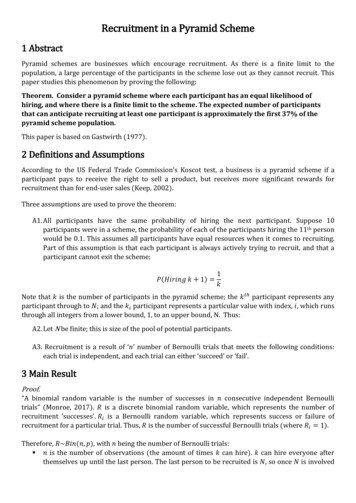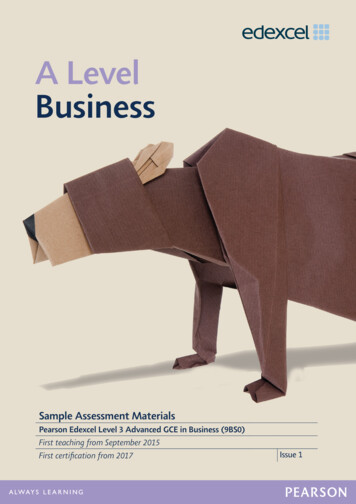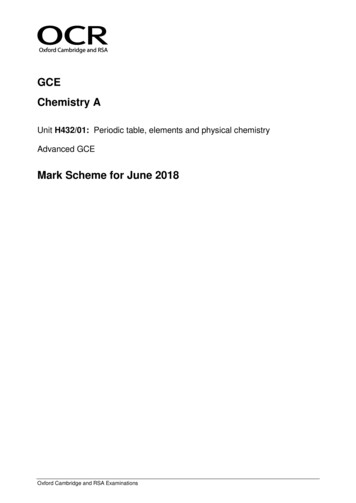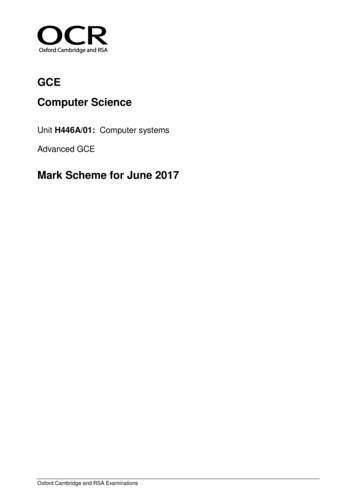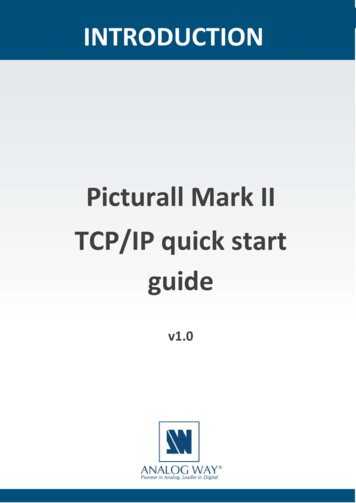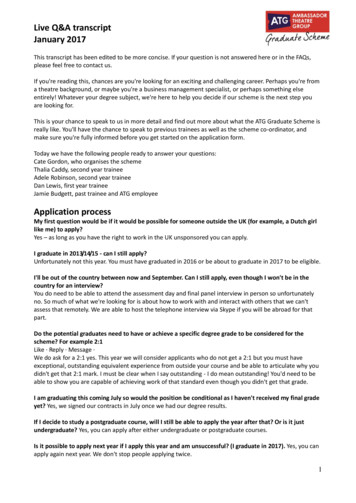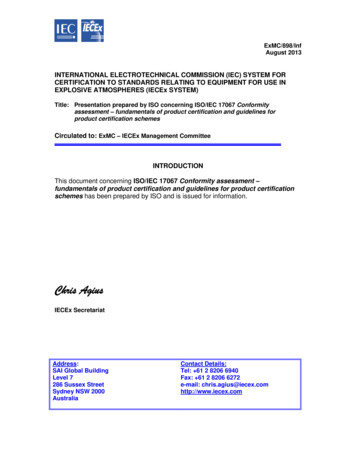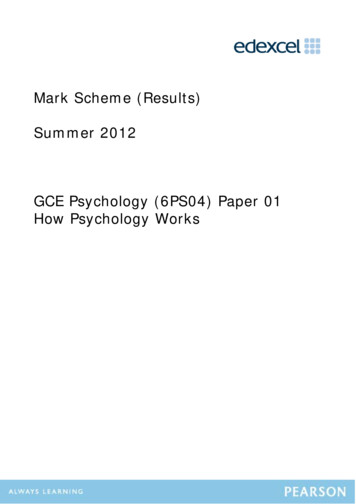
Transcription
Mark Scheme (Results)Summer 2012GCE Psychology (6PS04) Paper 01How Psychology Works
Edexcel and BTEC QualificationsEdexcel and BTEC qualifications come from Pearson, the world’s leading learningcompany. We provide a wide range of qualifications including academic,vocational, occupational and specific programmes for employers. For furtherinformation, please call our GCE line on 0844 576 0025, our GCSE team on 0844576 0027, or visit our qualifications website at www.edexcel.com. Forinformation about our BTEC qualifications, please call 0844 576 0026, or visit ourwebsite at www.btec.co.uk.If you have any subject specific questions about this specification that requirethe help of a subject specialist, you may find our Ask The Expert email servicehelpful.Ask The Expert can be accessed online at the following ernatively, you can speak directly to the subject team at Pearson aboutEdexcel qualifications. Their contact details can be found on this link:www.edexcel.com/teachingservicesPearson: helping people progress, everywhereOur aim is to help everyone progress in their lives through education. We believein every kind of learning, for all kinds of people, wherever they are in the world.We’ve been involved in education for over 150 years, and by working across 70countries, in 100 languages, we have built an international reputation for raisingachievement through innovation in education. Find out more about how we canhelp you and your students at: www.pearson.com/ukSummer 2012Publications Code UA032848All the material in this publication is copyright Pearson Education Ltd 2012
General Guidance on Marking – GCE PsychologyAll candidates must receive the same treatment.Examiners should look for qualities to reward rather than faults to penalise. This does NOT meangiving credit for incorrect or inadequate answers, but it does mean allowing candidates to be rewardedfor answers showing correct application of principles and knowledge.Examiners should therefore read carefully and consider every response: even unconventional answersmay be worthy of credit.Candidates must make their meaning clear to the examiner to gain the mark. Make sure that theanswer makes sense. Do not give credit for correct words/phrases which are put together in ameaningless manner. Answers must be in the correct context.Crossed out work should be marked UNLESS the candidate has replaced it with an alternativeresponse.When examiners are in doubt regarding the application of the mark scheme to a candidate’s response,the Team Leader must be consulted.Using the mark schemeThe mark scheme gives: an idea of the types of response expected how individual marks are to be awarded the total mark for each question examples of responses that should NOT receive credit (where applicable).12345/ means that the responses are alternatives and either answer should receive full credit.( ) means that a phrase/word is not essential for the award of the mark, but helps theexaminer to get the sense of the expected answer.[ ] words inside square brackets are instructions or guidance for examiners.Phrases/words in bold indicate that the meaning of the phrase or the actual word is essentialto the answer.TE (Transferred Error) means that a wrong answer given in an earlier part of a question isused correctly in answer to a later part of the same question.Quality of Written CommunicationQuestions which involve the writing of continuous prose will expect candidates to: show clarity of expressionconstruct and present coherent argumentsdemonstrate an effective use of grammar, punctuation and spelling.Full marks can only be awarded if the candidate has demonstrated the above abilities.Questions where QWC is likely to be particularly important are indicated “QWC” in the mark schemeBUT this does not preclude others.
Section A Clinical PsychologyQuestionnumbersQuestions1–3(except2aii and2aiii)QuestionNumber1(a)General InstructionsMarking points are indicative, not comprehensive and other points should becredited. In all cases consider “or words to that effect”. Each bullet point is a markunless otherwise stated and each point made by the candidate must be clearly andeffectively communicated.QuestionDescribe the procedure of one study you have learned about thatinvestigated schizophrenia. (Do not use Rosenhan’s study as this doesnot investigate the disorder of schizophrenia).AnswerNo credit for results and/or conclusions.Study must be investigating schizophrenia though this can be anyaspect of the disorder.Max 2 marks for generic procedure points.If at part (a) the study is not clear or is a mixture, please look at part(b) to identify the study. If the description is an amalgam of two ormore studies mark all and credit the best (take part (b) into account aswell).If the study is one you do not know/recognise and cannot find, refer toyour team leader. The study does not need to be named to gain fullcredit.No marks for aim(s), results or conclusion(s)Suitable studies include Goldstein, Lewine et al, Heston, Gottesman,Gottesman & Shields, Randrup & Munkvad, there are others.No credit for Rosenhan.e.g. Goldstein 1988 The original sample consisted of 199 schizophrenics, both male& female/eq; All were rediagnosed 10 years later with the newer version ofDSM/eq; Everyday functioning was assessed using a variety of measuresincluded marital status, occupational status, peer relationships,isolation and interests (at least 2 from list)/eq; The number and duration of hospitalisations over the ten yearperiod was measured/eq;Gottesman 1991 120 case histories used in the Gottesman and Shields (1987)study were used for the reassessment/eq; Diagnosis using DSM, RCD & Schneider’s first rank symptomswere compared/eq; Each case history was independently reassessed by eightdifferent clinicians/eq; Clinicians were asked to make a diagnosis and assess theseverity of the disorder based on the case notes/eq;Mark(4 AO1)
e.g. Lewine et al 1990 A group of schizophrenic patients, a group of non-schizophrenicpatients and a control group were tested/eq; Those participants with a mental disorder were recruited throughthe social worker referral network/eq; Each participant was given a physical examination, an EEG, anECG medical records were checked and a semi structuredinterview conducted (2 marks)/eq; (1 mark available for a list of2 items) Doses of chlorpromazine were checked to ensure there was nosignificant difference between male and female dosagelevels/eq; MRI imaging focusing on the corpus callosum was used/eq; A questionnaire to determine handedness was administered/eq;Randrup & Munkvad Male white rats aged from 3-6 months were used/eq; All rats were housed individually for the period of the study/eq; Rats were observed for a period of time before administration ofthe drugs to get a baseline measurement of behaviour/eq; Rats were injected with amphetamines (subcutaneously)according to bodyweight/eq; Each animal was observed continuously for a 6 hour periodfollowing the injection/eq;Goldstein 1999 29 patients diagnosed with schizophrenia were matched with 29healthy participants Matching was done on age, sex, ethnicity,(parental SES, readingability and handedness)/eq; All 29 controls were screened for psychopathologies/eq; Brain scans were used to measure the size of the brain/eq; Volumes of different areas of the brain were compared/eq; Adjustments to volumes were made for head size/eq; 3D MRI scans were taken so that volume, white matter and greymatter could all be measured/eq;Look for other appropriate marking points.
QuestionNumber1(b)QuestionEvaluate the study for which you have described the procedure in part(a).AnswerIf (a) is blank but (b) correctly evaluates a suitable study full marksmay be awarded. If (a) is incorrect but within clinical and (b) evaluatesthe study described in (a) then max 2. If (b) evaluates a different studythan in part (a) no marks.MarkMax 2 for generic evaluation pointse.g. Goldstein 1988 The study used a large sample and was able to retain themthrough the use of interviews and such measures at the start ofthe study and hospital records later/eq; The re-diagnosis was conducted by two independent expertswho were unaware of the purpose of the study/eq; There is support from other studies e.g. Angermeyer et al(1987) who found similar results showing premorbid history wasa predictor of outcome/eq; Data such as number and duration of hospital stays is objectiveand reliable/eq; Although men and women were matched for employment statustypes of jobs varied between the sexes/eq; No participants were over the age of 45 at the start of the studywhich may cause gender bias as a significant percentage ofwomen do not have their first episode before 45/eq;Gottesman 1991 As the twins were identified as MZ/DZ prior to geneticfingerprinting there were likely to be at least some wronglyclassified/eq; The variability in diagnosis among the eight cliniciansdemonstrates the problems involved in diagnosingschizophrenia/eq; Gottesman included many peripheral disorders not usuallyconsidered to be schizophrenia (e.g. schizophreniform disorder)in the schizophrenia statistics/eq; This may have distorted findings as Gottesman claims adiagnosis of schizophrenia even when only one or two episodeshave been experienced/eq; Using eight different clinicians and amalgamating their diagnosesso that those who diagnosed very few and those who diagnoseda large number were tempered by the middle values gives amore robust estimate of the number of twins with schizophrenia(2 marks)/eq;e.g. Lewine et al 1990 Differences in hormonal patterns which are thought to underliesome differences in brain morphology were not measured by thestudy so cannot be taken into account/eq; The MRI sample had only 4 schizophrenic females compared to27 males making comparisons very difficult/eq; Results are speculative because of the small sample sizes/eq; The suggestion that the data support a diathesis-stress model of(4 AO2)
onset, because a similar percentage of non-schizophrenics andof schizophrenics has a positive MRI scan, is speculative/eq;Use of handedness data allows the researchers to rule outhemispherical dominance as a factor in schizophrenia/eq;While embracing abnormalities in the corpus callosum as apossible factor in male schizophrenia the researchers fail tosuggest any physical aspects of the brain that may be associatedwith female schizophrenia/eq;Randrup & Munkvad Results from rats may not generalise to humans so the resultsmay not help understand schizophrenia/eq; The results are only valid if it is true that excess dopamine in theCNS is causing the symptoms of schizophrenia/eq; As the observation of a rat was conducted by one researcher it ispossible that researcher bias could have affected data collection(1st mark) although there were two researcher and atechnician collecting data so there should be sufficient variationto combat this(2nd mark)/eq; The researchers gained baseline data first so they were able tosee how amphetamines changed the rats’ behaviour/eq;Goldstein 1999 The matching of a healthy control group with the schizophrenicpatients meant that comparisons were reasonably valid/eq; Participants all gave informed consent prior to the study so ithad good ethical standards in that respect/eq; Patients were all recruited from outpatient clinics whereashealthy controls responded to advertisements in the press so itis possible there were systematic differences in personality/eq; A minimum IQ of 70 was set, however it is doubtful whethersomeone near the lower limit of the range would be ableunderstand the isues described to them prior to giving informedconsent/eq; Inter-rater reliability for the assessment of the brain scans wasgenerally high though three areas (frontal operculum, basalforebrain and occipital pole) had low correlation coefficients/eq;Look for other appropriate marking points.
QuestionNumber2(a)(i)QuestionDuring your study of clinical psychology you studied a key issue. Youalso produced a leaflet relating to this key issue.Clip all of2a & 2bWho were the target audience for your leaflet?AnswerMarkVery broad terms e.g. children not creditworthy as issues like agewould affect The key issue must relate to an issue in clinical psychology or 0markse.g. Families of those suffering from e.g. depression/eq;Someone about to embark on a course of therapy/eq;(1 AO3)Look for other reasonable marking pointsQuestionNumberQuestion2(a)(ii)Outline the intended outcome of your leaflet.AnswerMarkMark according to levels. Read the content, start at the top level, workdown accordingly The key issue must relate to an issue in clinical psychology or 0marks – this applies to (aiii) and (b) as wellAnswer must seem relevant to the target audience identified. If notarget audience is identified full credit can be gained provided thepurpose is relevant to a set of individuals.Although you will not be marking the target audience look to ensure theoutcome of the leaflet matches with the target audience stated in 2ai. Ifthe stated intended outcome seems inappropriate for the targetaudience then no marks can be awarded here.e.g. The leaflet was designed to inform the family of those sufferingfrom depression To explain the role of Community Psychiatric Nurses and how tocontact them in an emergency To tell readers which treatments were available for their disorder For example it explained CBT might be offered and how thefamily can support someone undertaking this therapy The leaflet gave information on common treatments foranorexia, their advantages, disadvantages and success rates soa patient could decide which treatment may suit them bestLevels:0Intended outcome does not match target audience1Some relevance to target audience but either not developed or ofquestionable relevance2Intended outcome clear and appropriate(2 AO3)
QuestionNumber2(a)(iii)QuestionExplain one reason why you used the material you did for the contentof your leaflet.AnswerMarkMaterial should link (i) & (ii) by explaining how content fitted the targetaudience and the purpose. If more than one reason mark all and creditthe best.Indicative content The leaflet explained the main symptoms likely to be seen in adepressed individual and how to handle the individual, such ashow to spot the likely precursors of suicidal thoughts to helprelatives care for the patient (Level 2) The leaflet gave a list of the different treatments and therapiesavailable and explained how a patient is likely to progress over aperiod of therapy so the client/family would be prepared for this(Level 2) The leaflet explained what actions family members could take tosupport someone undergoing therapy (Level 1) The material in the leaflet was designed to be easy to read forpeople who had no previous knowledge of mental health issues,so it used simple terms and very positive material as we thoughtit was important not to distress people about their diagnosis(Level 2) We used a case study of a teenager with anorexia so that theissue became real for the Target audience to help them relate tothe issues (Level 2)0No rewardable material1Reason either only explains why or how or is poorly developed2Reason is well explained showing both why and how or is rich inrelevant detailLook for other reasonable marking points(2 AO3)
QuestionNumber2(b)QuestionWhen you created the leaflet described in part (a) you will have usedsecondary data. Explain how you gathered your secondary data.AnswerMarkRead through all of answer before awarding marks. Refer to levelsbelow indicative contentIndicative content 0We searched the internet for evidence about what types oftreatments are used for depression and how successful they are‘NHS Choices’ provided us with a list of the different ways oftreating depression available on the NHSWe were able to list these and group them according to typesWe visited websites of private clinics and found out whattherapies they useWe collected data on the number of prescriptions forantidepressants from the Mind websiteNothing worthy of credit.1 Brief indication of where data collected from. Will be identifiable assecondary data.(Likely to be only one source of data. Likely to include irrelevancies).2 Description will include information on at least two different sourcesof data or one source of information and a detailed description of howthe data were extracted from the source.3 A good resume such that a clear understanding of both thesource(s) of data and the means used to collect the data are explained.(Likely to refer to some aspect of how data used).4 A good resume such that a clear understanding of both thesource(s) of data and the means used to collect the data are clearlyexplained. In addition there will be some indication of how decisionswere made about the selection and/or treatment of the material.(4 AO3)
QuestionNumber3(a)QuestionYou have learned about either systematic desensitisation or the tokeneconomy programme as treatments/therapies within the LearningApproach.Describe one of these treatments/therapies as it is used in clinicalpsychology.AnswerClip with3(b)MarkIf both therapies are described mark all and credit the best. No creditfor therapies other than the two mentioned in the question.Answers that focus on another use e.g. in prisons with only a singlereference linking to clinical and/or give general points only, Max 2marks.Examples may gain credit but must be appropriate, e.g. rewarding anperson with anorexia with chocolate is not appropriateSystematic desensitisation Uses the principles of classical conditioning to treat phobias/eq; The individual creates a hierarchy of fear ranging from the leastto the most frightening aspect of their phobia/eq; They are taught to be able to relax and become calm/eq; The therapist will start with the least frightening level and guidethe person through, getting them to relax at each stage/eq; Progression onto the next level only occurs when the patient iscomfortable and in control of the situation/eq; It relies on the principle of reciprocal inhibition to achieve itsresults/eq;Token economy Uses the principles of operant conditioning to change behaviourof people with anorexia/eq; Target behaviours are identified and the rewards agreed withthe patient/client/eq; Each time a desired behaviour is performed the patient will berewarded with a token/eq; Tokens can then be exchanged for privileges, such as leavingthe clinic for the weekend/eq; Over time the tokens will become harder to achieve as thebehaviour is shaped/eq;Look for other reasonable marking points(4 AO1)
QuestionNumber3(b)QuestionMagda has mental health issues and has been recommended therapyby her psychiatrist. Her psychiatrist has suggested that she wouldbenefit from a behavioural therapy.Clip with3(a)Evaluate the treatment/therapy you described in (a) with reference to Magda’smental health issues.AnswerEvaluation must relate to therapy described in (a) or 0 marks.If (a) is blank but (b) correctly evaluates one of the two therapies thenfull credit can be gained.If (a) is incorrect but (b) provides a correct evaluation of that therapythen max 3 marks.If no mention of Magda max 3 marks. Evidence is evaluation.Marking points that are overly brief and simplistic (e.g. quick & cheap)with no development or qualification gain no creditSystematic desensitisation It is only likely to be of help if Magda has a phobia or similaranxiety disorder/eq; It is unlikely to be very effective if her disorder is agoraphobia,as SD only tends to be effective for specific phobias/eq; It is a very ethical therapy as Magda would be in control of thespeed and progress at all times/eq; Magda agrees the hierarchy with her therapist so knows what toexpect next when moving through the programme/eq; It only treats the observable symptoms Magda may startsuffering from other problems if there are underlying causes/eq; Psychoanalysis looks at the underlying cause and so might bemore effective than systematic desensitisation/eq; Systematic desensitisation is more acceptable than flooding totreat a phobia so is more ethical/eq; The therapy is relatively quick and cheap compared topsychoanalysis meaning Magda will improve very quickly/eq; Systematic desensitisation is more acceptable than flooding totreat a phobia as it is more ethical/eq;Token economy Magda would need to be in either a psychiatric unit or half wayhouse in order to use TE successfully/eq; Careful monitoring of behaviour is essential if the programme isto be successful and this is hard to do when not in aninstitution/eq; There is no guarantee that the new behaviour Magda learns willbe retained once it is no longer reinforced/eq; Magda may just be exploiting the situation in order to gain therewards and have no intention of changing her behaviour/eq; However most psychiatric patients are not sufficiently in controlof their own behaviour to exercise this level of control/eq; Most psychiatric patients wish to change their behaviour as theyfind the symptoms of their disorder distressing, meaning theywill be very willing to co-operate/eq; If staff on the ward/in the half way house do not apply the TEPconsistently this may confuse Magda as she will not know whatstandards of behaviour are expected of her/eq;Look for other reasonable marking points.Mark(5 AO2)
QuestionNumber4(a)QuestionYou have studied one disorder from the following list: unipolar depression bipolar depression phobias obsessive compulsive disorder anorexia nervosa bulimia nervosa.Outline one explanation for your chosen disorder.AnswerDisorder must be one of those listed in the question or 0 marks.Answers which are generic depression or eating disorders can only gaincredit for one specific disorder.If outline does not match the stated disorder mark for the disorderoutlined.Explanations can be specific or general to an approach.If more than one explanation mark all and credit the best.No credit for symptomse.g. Unipolar depression Depression may be caused by faulty thought patterns ADDMORE/eq; The depressed individual believes that others are critical ofthem/eq; They will interpret events in a negative way such as someonenot speaking to them because they don’t like them/eq; They will become more socially withdrawn as they get negativeexperiences from interactions/eq; Depression is caused by a shortage of one or more monoamineneurotransmitters/eq;The low level of serotonin is thought to induce anxiety/eq;Dopamine and noradrenalin are also believed to be low/eq;The individual may produce too much monoamine oxidase so theneurotransmitters are broken down too fast/eq;People may have a genetic predisposition (shortened allelles ofthe 5-HTTgene) that means they produce less serotonin whenunder stresse.g Anorexia nervosa One explanation for anorexia is from social learning as peoplesee size zero models and celebrities and try to copy them/eq; In the initial stages as they lose weight they gain praise andattention/eq; This reinforces the slimming behaviour so maintaining theweight loss cycle/eq; One theory is that unconsciously the individual wishes to remaina child/eq;They therefore stop eating as this maintains a boyish figure/eq;It also stops menstruation, another way of delaying puberty/eq;Cognitive explanation says that there is a faulty perception ofbody size/eq;Clip with4(b)Mark(3 AO1)
The brain distorts the body image so that people see themselvesas too large even when they are not/eq;They therefore believe they need to lose weight in order tobecome a desirable size/eq;The individual becomes obsessed by their believed body imageand the need to be slimmer/eq;e.g. Bulimia nervosa Low self esteem can cause bulimic behaviour/eq; The person has excess concern about their body image and theopinion of peers/eq; This leads the individual to want to purge themselves to attemptto control their weight/eq;e.g. Bipolar depression It is likely that there is a genetic basis for bipolar disorder/eq; It is likely that the genetic abnormality causes imbalances in theneurotransmitters/eq; These will cause both the euphoric and depressed phases of thedisorder/eq;e.g. Phobias Learning theory suggests a phobia is caused by classicalconditioning/eq; The target object is paired with something already feared/eq; e.g. A dog barking when a child plays in a sand pit pairs thesand with the dog/eq; The phobia is maintained through negative reinforcement/eq;e.g. Obsessive compulsive disorder OCD may be caused by the over responsiveness of parts of thesub-cortex to anxiety provoking situations/eq; These areas send a danger signal to the cortex whichmismatches with what the cortex perceives/eq; This generated confusion and the anxiety is converted into OCDbehaviour as a coping mechanism/eq; OCD sufferers have a faulty pathway involving the caudatenucleus/eq;The orbital frontal cortex sends worry signals to the thalamuswhich in turn feeds back to the OFC/eq;However in OCD the caudate nucleus does not damp down thefeedback system so the thalamus becomes over excited/eq;This produces symptoms of excessive worrying/eq;The psychodynamic approach suggests that OCD is themanifestation of guilt from an overactive superego/eq;The particular compulsion is likely to be linked to a childhooddesire that was never fully resolved/eq;e.g. checking taps are switched off because of an unconsciousdesire to flood the house/eq;Look for other reasonable marking points.
QuestionNumber4(b)QuestionUsing research evidence, evaluate the explanation you have outlined in(a). In your answer make at least one comparison with a differentexplanation for the disorder you are using.AnswerIf (a) is blank but (b) correctly evaluates an appropriate explanationthen full marks can be gained.If (a) gives explanation(s) for a disorder not listed then max 2 marks.If (a) is correct but (b) evaluates a different explanation then no creditcan be given.If no comparison is made max 3.If no research evidence max 3.e.g. Unipolar depression The cognitive explanation suggests faulty thought processeswhich fits better with the high success of CBT as a treatment/eq; The faulty thoughts could be a symptom of chemical imbalanceand not the cause of depression/eq; There is evidence that the clinically depressed do interpretevents in a more negative way than non-sufferers/eq; Clark & Beck (1999) found evidence at all levels of depressionfor a negative cognitive triad that responded to CB therapies/eq; If neurotransmitter imbalance caused depression, drugsdesigned to treat this would always work, but they don’t/eq;The level of neurotransmitters rises very quickly once onmedication but any improvement associated with the drugstakes some time to manifest itself/eq;In some instances the drugs do work almost instantaneouslysuggesting that depression is not a unitary disorder/eq;There is always concern that the low levels of neurotransmitterscould be effect rather than cause/eq;Rausch et al (2002) showed the success of SSRI treatment isdependent on the sufferer’s genes, suggesting another aspect tothe biological substrate/eq;e.g. Anorexia nervosa Everyone in Western culture is exposed to the same models yetonly a small percentage adopt anorectic behaviour /eq; Evidence from several studies (e.g. Nasser, Becker) has shownan increase in the incidence of anorexia in groups exposed towestern cultural images, supporting SLT/eq; Harrison & Cantor (1997) showed a significant predictiverelationship between the reading of thinness promotingmagazines and the onset of anorexia Psychodynamic explanations of remaining as a child cannotexplain the onset of anorexia post puberty or in males/eq;Patton et al (1999) found that a history of dieting was the singlemost reliable predictor of onset, meaning unconsciousmotivations do not play a major role/eq;The control that anorectic behaviour gives over diet and weightcan be argued to substitute for the maturational development ofidentity in adolescence so supporting the psychodynamicClip with4(a)Mark(4 AO2)
view/eq; Evidence from body mapping experiments shows that cognitivemapping if parts of the body is poor in everyone/eq;However if this is so common it is surprising that everyone doesnot suffer from anorexia/eq;Evidence from anorectics shows that cognitive feedback onlosing weight is a powerful incentive to keep losing weight/eq;e.g. Bulimia nervosa Vohs et al (2001) found that poor body image and low selfesteem were reliable predictors of bulimia/eq; Baumeister et al (2009) showed that high self esteem reducedthe risks of bulimia in female adolescent though not inmales/eq; The low self esteem that predicts bulimia is thought to originatein high levels of self consciousness during adolescent identitycrises (Fairburn 1993)/eq; Bulimic patients report experiencing more stress than nonbulimics suggesting they are affected by stress more rather thanit being just to do with self esteem/eq;e.g. Bipolar depression McGuffin(2003) found 85% concordance in MZ twins for bipolardisorder suggesting a strong genetic link/eq; Craddock & Jones (1999) found 40-75% concordance in MZtwins/ 5-10% concordance in first degree relatives/eq; Epidemiological evidence puts the risk factors within a family at50-75% for a child where both parents have the disorder and25% if only one parent is a sufferer/eq; Genetic research suggests several genes responsible but rarelyis the genetic connection a dominant gene/eq;e.g. Phobias Variability in the susceptibility of people to developing phobiassuggests that learning cannot be the only reason for theiracquisition/eq; Specific phobias do seem to be linked to specific experiences butthe same is not true of agoraphobia/eq; Walder et al (1987) demonstrated systematic desensitisati
Aug 16, 2012 · GCE Psychology (6PS04) Paper 01 How Psychology Works . Edexcel and BTEC Qualifications Edexcel and BTEC qualifications come from Pearson, the world’s leading learning company. We provide a wide range of qualifications including academic, vocational, occupa

